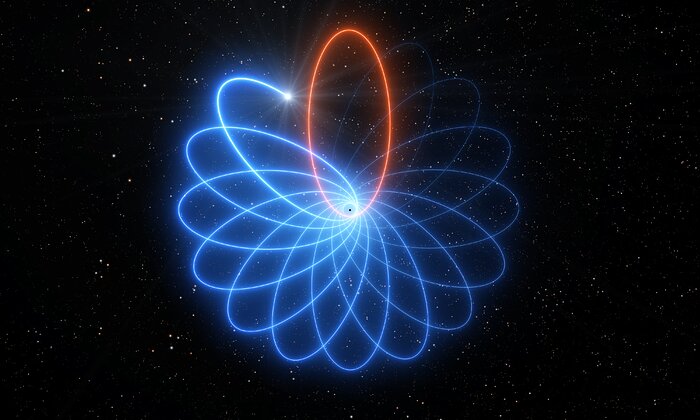The supermassive black hole at the center of the Milky Way serves as a unique laboratory for testing predictions of general relativity. In a new study, researchers report that a long-studied star—called S2 or sometimes S-02—moves in a rosette-shaped orbit around this black hole, just as general relativity mandates a star should. Nearly three decades’ worth of observations have borne out this observation that S2's orbit is not a simple ellipse. Instead, the orbit precesses, meaning that each time the star completes a loop around the black hole, the closest point of the orbit rotates away from the previous orbit's closest point, resulting in a rosette pattern. These findings are the first to measure precession by a star around a supermassive black hole. See also: Ellipse; Orbital motion; Precession; Star

A key piece of evidence for the existence of a colossal black hole (which cannot be directly seen) at the Milky Way's core is the extreme behavior of a group of stars in this location. The stars, known as S stars, rapidly revolve about a tremendous point of unseen mass. Extrapolations from the parameters of the orbits indicate that the weight of the invisible mass must be equivalent to about four million Suns in a small span no larger than our solar system. The only astrophysical object that could concentrate so much mass in this way is a black hole—an ultra-dense object whose gravity is so strong that light cannot escape. See also: Black hole
Whereas black holes with relatively small masses are relatively common objects, supermassive black holes are generally found only in the centers of galaxies. The Milky Way's center is the only galactic core close enough for scientists to precisely monitor movements of individual stars, such as S2. Astronomers have tracked S2 for 27 years using a variety of instruments—in particular, those at the Very Large Telescope facility located in Chile. A single orbit of S2 around the Milky Way black hole takes 16 years. Given the observation window to date, in August 2019, scientists were able to report that light from S2 exhibited gravitational redshift, an effect predicted by general relativity. For the April 2020 study, the same research team had gathered enough evidence to confirm that the star's orbit does undergo precession, likewise due to general relativity. See also: Milky Way Galaxy; Star's orbit of a supermassive black hole supports theory of relativity; Very Large Telescope
This precession occurs because of the way in which gravity causes spacetime—the physical geometry of the universe—to curve, as described by the general theory of relativity. First proposed by German-born U.S. theoretical physicist Albert Einstein in 1915, this theory has endured as the best explanation for the force of gravity. In this way, general relativity displaced Newtonian mechanics devised by English physicist and mathematician Isaac Newton in the late 17th century. According to Newton's laws of motion, gravitation, and other elements of classical mechanics, gravitationally bound bodies would remain in a steady, closed orbit (assuming no other bodies caused significant gravitational perturbations to this two-body system). General relativity, however, predicts that bound orbits precess forward in the plane of motion. See also: Classical mechanics; Gravity; Newton's laws of motion; Relativity; Spacetime
Telescope observations of S2 verified both this shift, technically known as Schwarzschild precession, and its degree, in concordance with general relativity's mathematics. The planet Mercury in our solar system also undergoes Schwarzschild precession in its orbit about the Sun. Astronomers had noted this phenomenon originally in the mid-19th century, yet it remained a mystery until Einstein formulated general relativity. Now, more than a century after Einstein's insights, his paradigm continues to provide precise descriptions of physical reality. See also: Mercury (planet)





